下記記事で、セッションデータをAzure Cache for Redisに格納するJavaアプリケーションを、複数のAzure App Serviceそれぞれに配置し、複数のAzure App Serviceが異なるドメインをもつ場合、セッションデータを互いに共有することはできないことを記載している。

ただし、複数のAzure App Serviceに、(メインドメインが同一の)サブドメインをもつカスタムドメインを設定すれば、セッションデータを互いに共有することができる。
今回は、Spring Bootを利用したJavaアプリケーションを、(メインドメインが同一の)サブドメインをもつ複数のAzure App Serviceに配置し、互いにデータ共有してみたので、そのサンプルプログラムを共有する。
前提条件
以下の記事の実装が完了していること。

また、以下の記事の手順に従って、2つのAzure App Serviceに(メインドメインが同一の)サブドメインをもつカスタムドメインを設定していること。

2つのAzure App Serviceに、実際に設定したカスタムドメインの内容は、以下の通り。
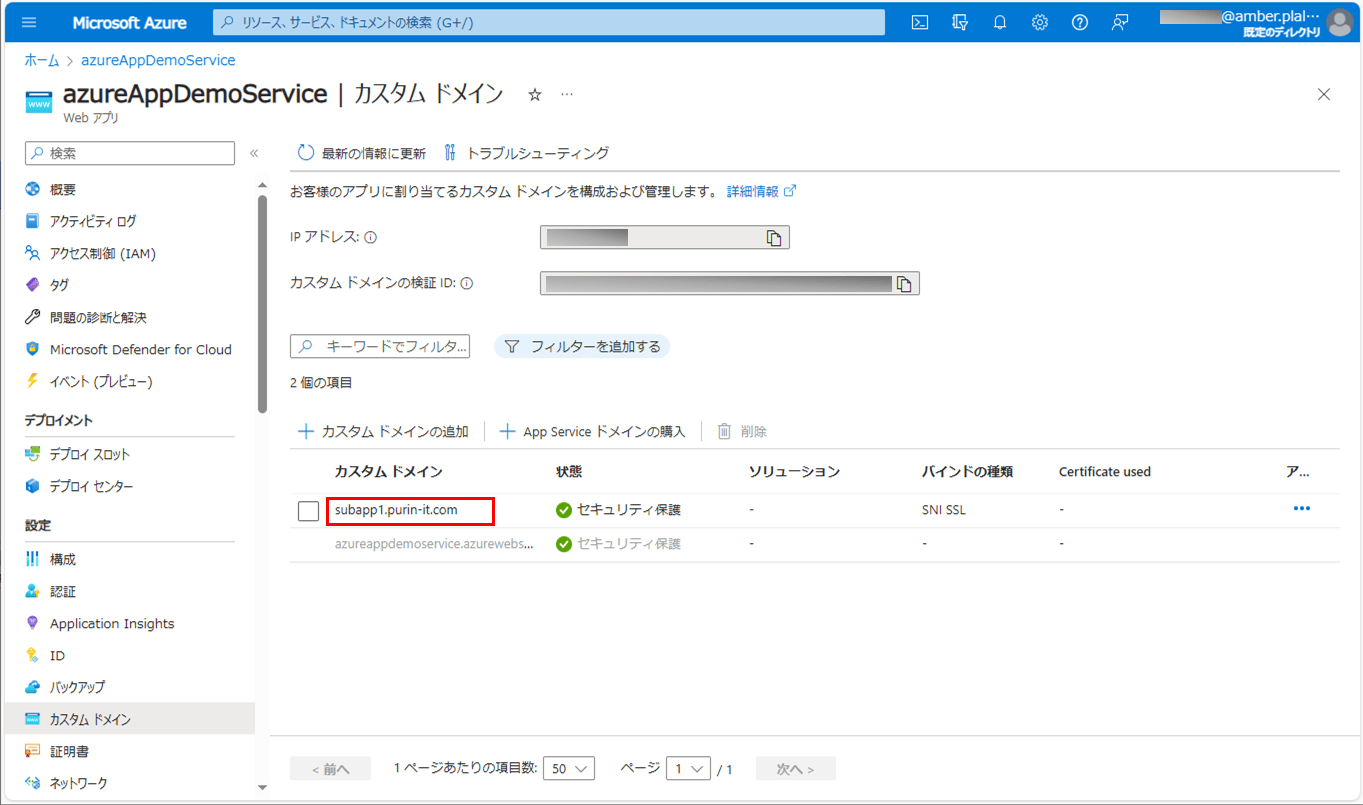
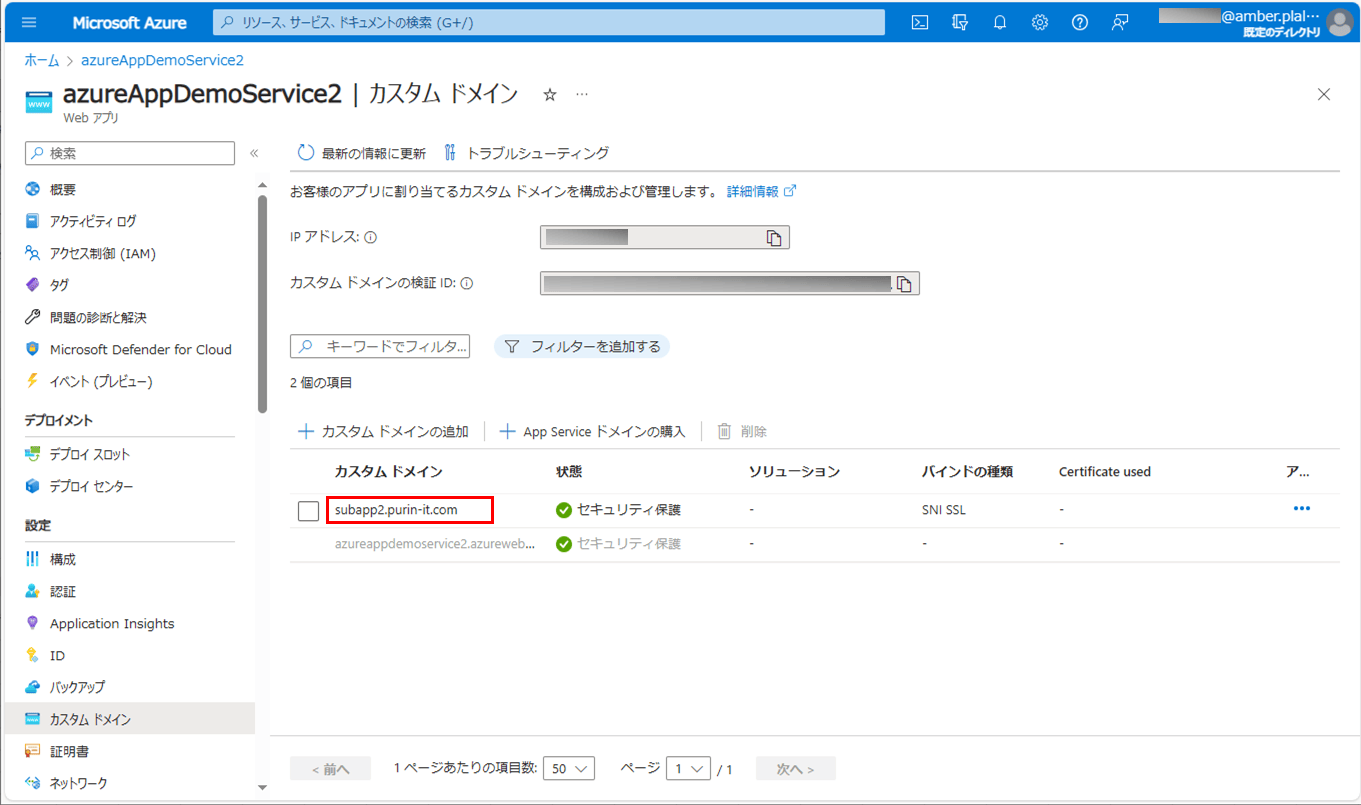
作成したサンプルプログラムの内容
作成したサンプルプログラム(呼び出し元のApp Service)の構成は、以下の通り。なお、下記の赤枠は、前提条件のプログラムから変更したプログラムである。
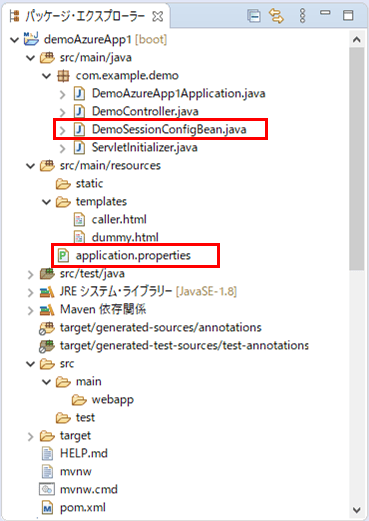
また、作成したサンプルプログラム(呼び出し先のApp Service)の構成は、以下の通り。なお、下記の赤枠は、前提条件のプログラムから変更したプログラムである。
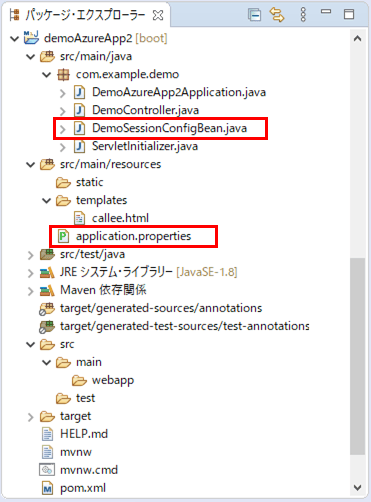
呼出元・呼出先のapplication.propertiesの内容は以下の通りで、ドメイン名(ローカル起動の場合localhost、Azure上ではメインドメイン)を設定している。
server.port = 8084 # 呼出先画面のURL demoAzureApp2.urlBase = http://localhost:8085/ #demoAzureApp2.urlBase = https://azureappdemoservice2.azurewebsites.net/ #demoAzureApp2.urlBase = https://subapp2.purin-it.com/ # Spring Sessionに関する設定 spring.session.store-type=redis spring.redis.ssl=true spring.redis.host=azurePurinRedis.redis.cache.windows.net spring.redis.port=6380 spring.redis.password=(Azure Cache for Redisのパスワード) # Spring SessionのCookieSerializerに設定するドメイン spring.session.domainname=localhost #spring.session.domainname=purin-it.com
server.port = 8085 # Spring Sessionに関する設定 spring.session.store-type=redis spring.redis.ssl=true spring.redis.host=azurePurinRedis.redis.cache.windows.net spring.redis.port=6380 spring.redis.password=(Azure Cache for Redisのパスワード) # Spring SessionのCookieSerializerに設定するドメイン spring.session.domainname=localhost #spring.session.domainname=purin-it.com
また、呼出元・呼出先のセッション設定を行うクラスは以下の通りで、Spring Sessionのクッキーに設定されるドメイン名の設定(CookieSerializer)を追加している。
package com.example.demo;
import org.springframework.beans.factory.annotation.Value;
import org.springframework.context.annotation.Bean;
import org.springframework.context.annotation.Configuration;
import org.springframework.data.redis.connection.RedisStandaloneConfiguration;
import org.springframework.data.redis.connection.lettuce.LettuceClientConfiguration;
import org.springframework.data.redis.connection.lettuce.LettuceConnectionFactory;
import org.springframework.data.redis.serializer.GenericJackson2JsonRedisSerializer;
import org.springframework.data.redis.serializer.RedisSerializer;
import org.springframework.session.data.redis.config.ConfigureRedisAction;
import org.springframework.session.data.redis.config.annotation.web.http.EnableRedisHttpSession;
import org.springframework.session.web.context.AbstractHttpSessionApplicationInitializer;
import org.springframework.session.web.http.CookieSerializer;
import org.springframework.session.web.http.DefaultCookieSerializer;
@Configuration
@EnableRedisHttpSession
public class DemoSessionConfigBean extends AbstractHttpSessionApplicationInitializer {
/** Azure上のRedisサーバーのホスト名 */
@Value("${spring.redis.host}")
private String redisHostName;
/** Azure上のRedisサーバーのポート番号 */
@Value("${spring.redis.port}")
private String redisPort;
/** Azure上のRedisサーバーのパスワード */
@Value("${spring.redis.password}")
private String redisPassword;
/** Spring SessionのCookieSerializerに設定するドメイン名 */
@Value("${spring.session.domainname}")
private String sessionDomainName;
/**
* Redisへの値の書き込み・読み込み手段を提供するシリアライザを生成する
* @return Redisへの値の書き込み・読み込み手段を提供するシリアライザ
*/
@Bean
public RedisSerializer<Object> springSessionDefaultRedisSerializer() {
return new GenericJackson2JsonRedisSerializer();
}
/**
* Spring SessionがAzure上のRedisのCONFIGを実行しないようにする
* @return Spring SessionがAzure上のRedisのCONFIGを実行しない設定
*/
@Bean
public static ConfigureRedisAction configureRedisAction() {
return ConfigureRedisAction.NO_OP;
}
/**
* Redisへの接続方法を生成する
* @return Redisへの接続方法
*/
@Bean
public LettuceConnectionFactory connectionFactory() {
RedisStandaloneConfiguration redisStandaloneConfiguration
= new RedisStandaloneConfiguration();
redisStandaloneConfiguration.setHostName(redisHostName);
redisStandaloneConfiguration.setPassword(redisPassword);
redisStandaloneConfiguration.setPort(Integer.parseInt(redisPort));
LettuceClientConfiguration lettuceClientConfiguration
= LettuceClientConfiguration.builder().useSsl().build();
return new LettuceConnectionFactory(redisStandaloneConfiguration
, lettuceClientConfiguration);
}
/**
* Spring Sessionのクッキーに設定されるドメイン名を設定する
* @return CookieSerializer(Cookie値を HttpServletResponseに読み書きするための設定)
*/
@Bean
public CookieSerializer configureDefaultCookieSerializer() {
DefaultCookieSerializer serializer = new DefaultCookieSerializer();
serializer.setDomainName(sessionDomainName);
return serializer;
}
}その他のソースコード内容は、以下のサイトを参照のこと。
https://github.com/purin-it/azure/tree/master/azure-multi-app-service-subdomain/
サンプルプログラムの実行結果(ローカル環境)
ローカル環境でサンプルプログラムの実行した結果は、以下の通り。
1) 呼出元・呼出先のapplication.propertiesの設定を、ローカル環境用に変更する。
server.port = 8084 # 呼出先画面のURL demoAzureApp2.urlBase = http://localhost:8085/ #demoAzureApp2.urlBase = https://azureappdemoservice2.azurewebsites.net/ #demoAzureApp2.urlBase = https://subapp2.purin-it.com/ # Spring Sessionに関する設定 spring.session.store-type=redis spring.redis.ssl=true spring.redis.host=azurePurinRedis.redis.cache.windows.net spring.redis.port=6380 spring.redis.password=(Azure Cache for Redisのパスワード) # Spring SessionのCookieSerializerに設定するドメイン spring.session.domainname=localhost #spring.session.domainname=purin-it.com
server.port = 8085 # Spring Sessionに関する設定 spring.session.store-type=redis spring.redis.ssl=true spring.redis.host=azurePurinRedis.redis.cache.windows.net spring.redis.port=6380 spring.redis.password=(Azure Cache for Redisのパスワード) # Spring SessionのCookieSerializerに設定するドメイン spring.session.domainname=localhost #spring.session.domainname=purin-it.com
2) 呼出元・呼出先のSpring Bootアプリケーションをそれぞれ起動する。
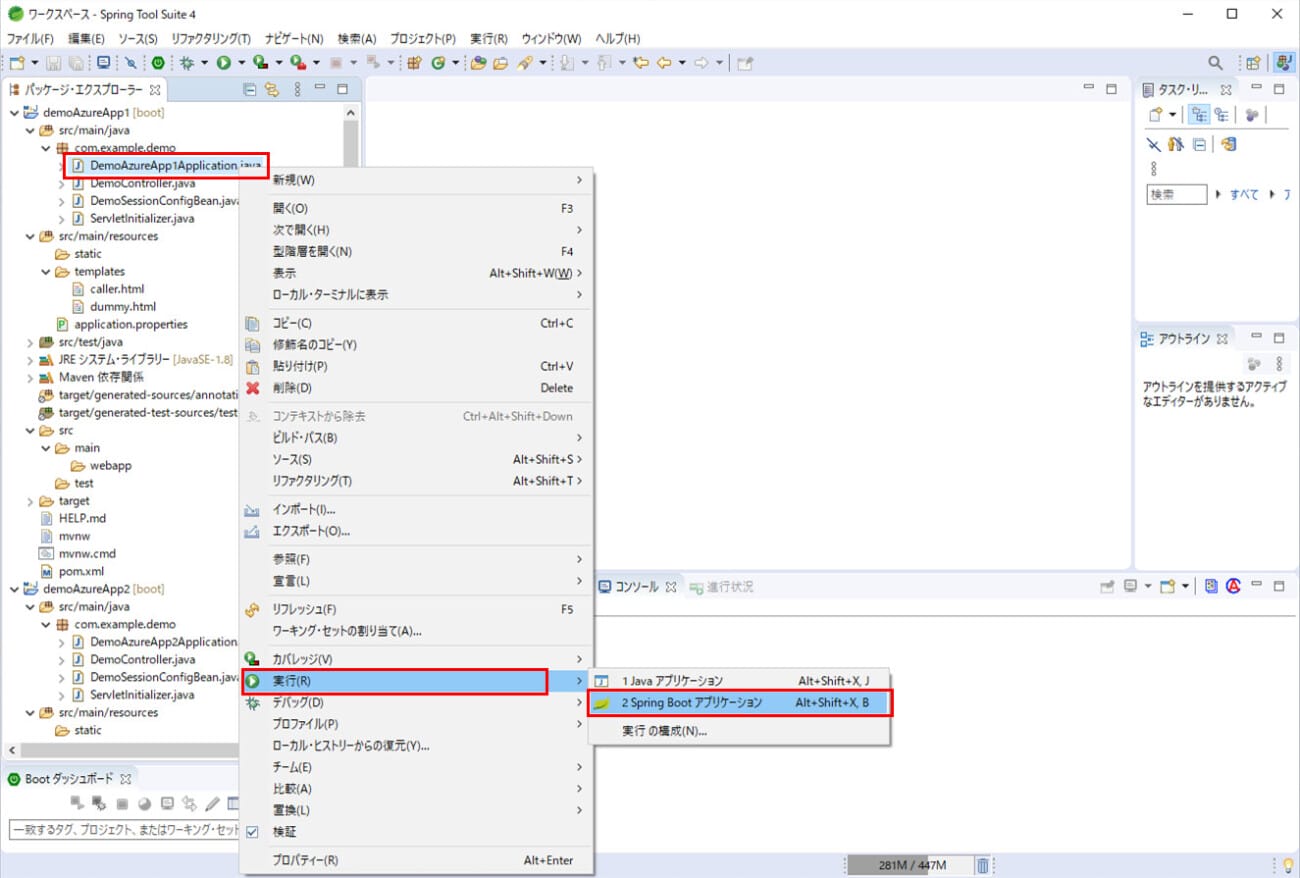
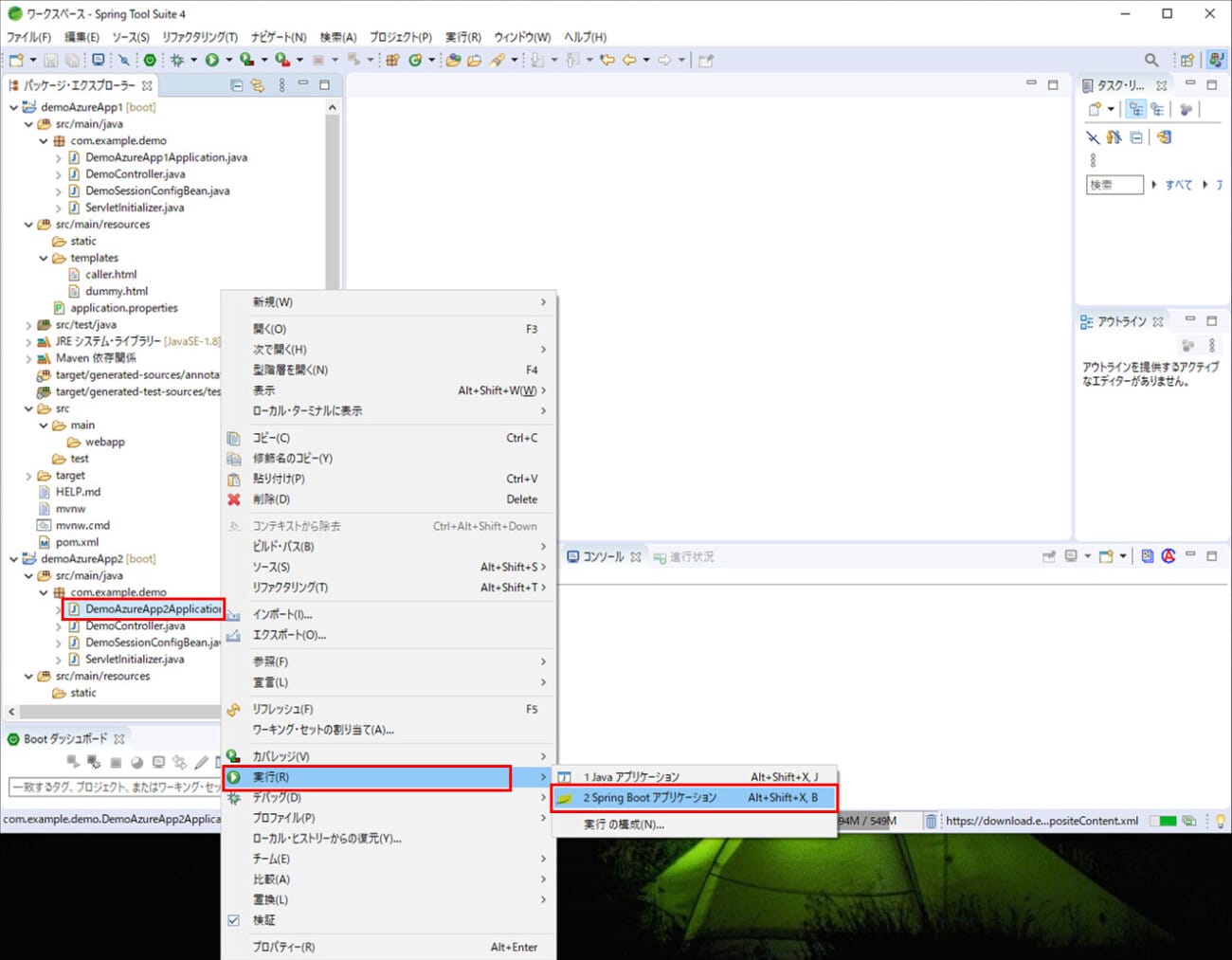
3)「http://localhost:(呼出元画面のポート番号)/」とアクセスすると、以下のように、呼出元画面が表示されることが確認できる。
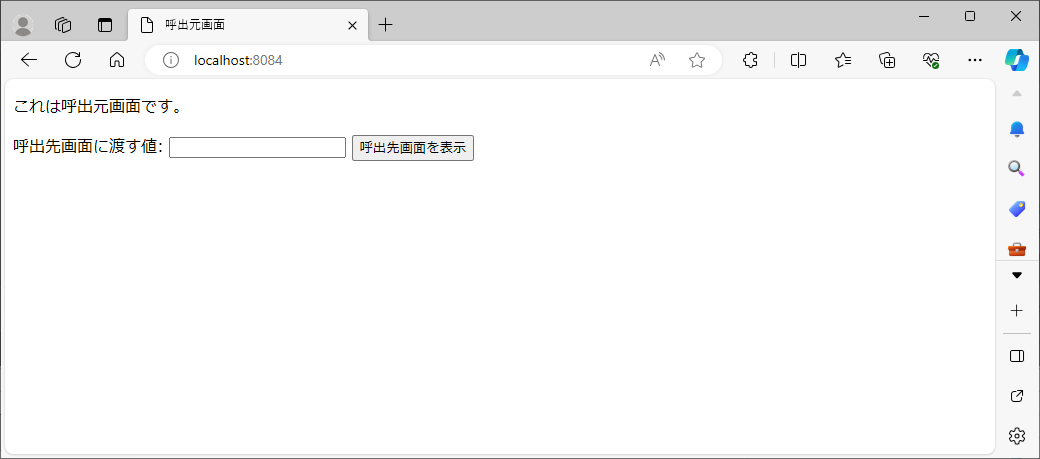
4) 呼出先画面に渡す値を指定し「呼出先画面を表示」ボタンを押下すると、以下のように、呼出先画面が表示され、呼出先画面に渡す値が表示されることが確認できる。
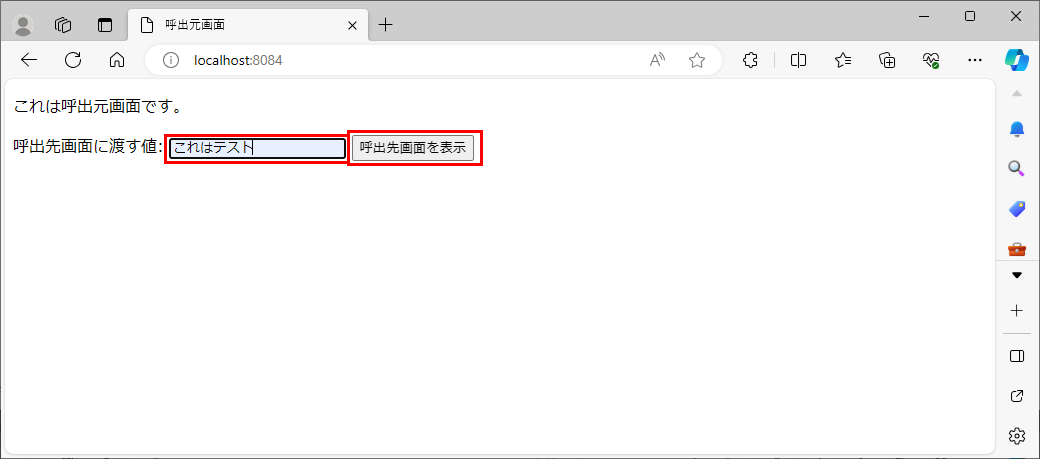
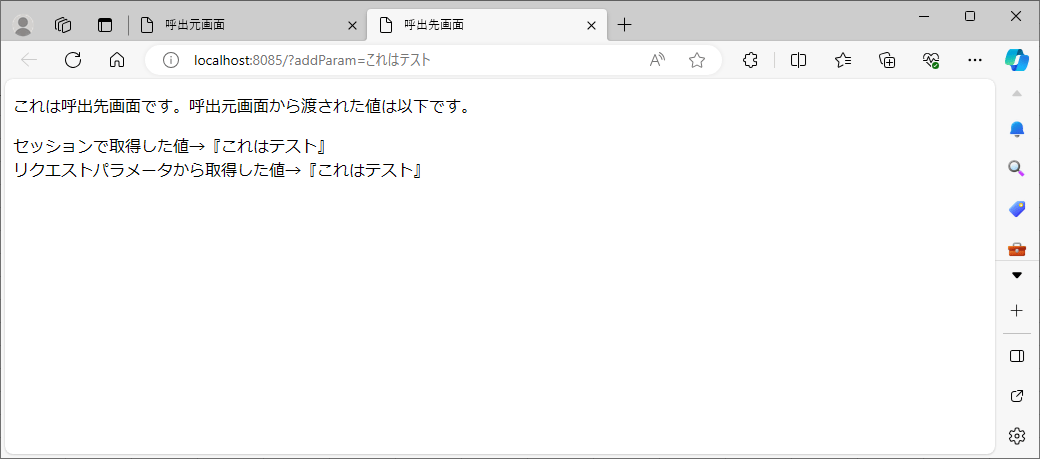
サンプルプログラムの実行結果(Azure環境)
Azure環境でサンプルプログラムの実行した結果は、以下の通り。
1) 呼出元・呼出先のapplication.propertiesの設定を、Azure環境用に変更する。
#server.port = 8084 # 呼出先画面のURL #demoAzureApp2.urlBase = http://localhost:8085/ #demoAzureApp2.urlBase = https://azureappdemoservice2.azurewebsites.net/ demoAzureApp2.urlBase = https://subapp2.purin-it.com/ # Spring Sessionに関する設定 spring.session.store-type=redis spring.redis.ssl=true spring.redis.host=azurePurinRedis.redis.cache.windows.net spring.redis.port=6380 spring.redis.password=(Azure Cache for Redisのパスワード) # Spring SessionのCookieSerializerに設定するドメイン #spring.session.domainname=localhost spring.session.domainname=purin-it.com
#server.port = 8085 # Spring Sessionに関する設定 spring.session.store-type=redis spring.redis.ssl=true spring.redis.host=azurePurinRedis.redis.cache.windows.net spring.redis.port=6380 spring.redis.password=(Azure Cache for Redisのパスワード) # Spring SessionのCookieSerializerに設定するドメイン #spring.session.domainname=localhost spring.session.domainname=purin-it.com
2) 以下のサイトの「App ServiceへのSpring Bootを利用したJavaアプリケーションのデプロイ」に記載した手順に従って、Azure App Service(2つ)それぞれに、呼出元・呼出先のJavaアプリケーションを配置する。

3) 呼出元のApp Service概要の「カスタムドメイン」のURLにアクセスすると、以下のように、呼出元画面が表示されることが確認できる。
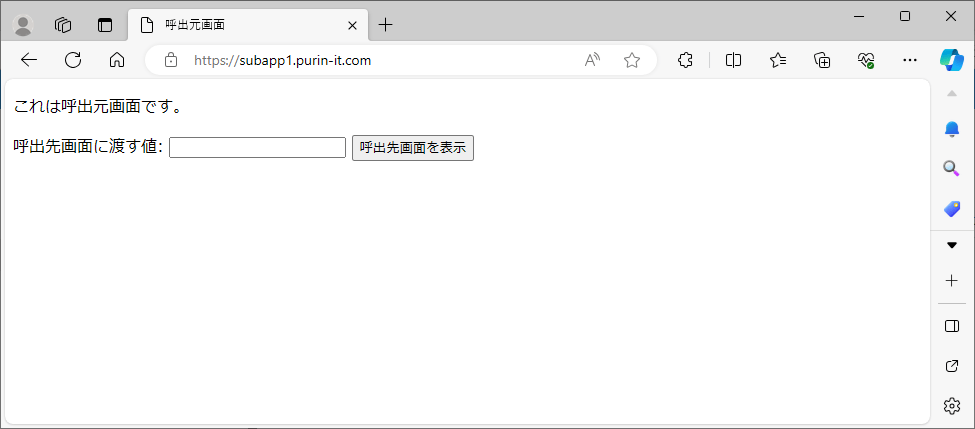
4) 呼出先画面に渡す値を指定し「呼出先画面を表示」ボタンを押下すると、以下のように、呼出先画面が表示され、セッションから取得したデータも表示されることが確認できる。
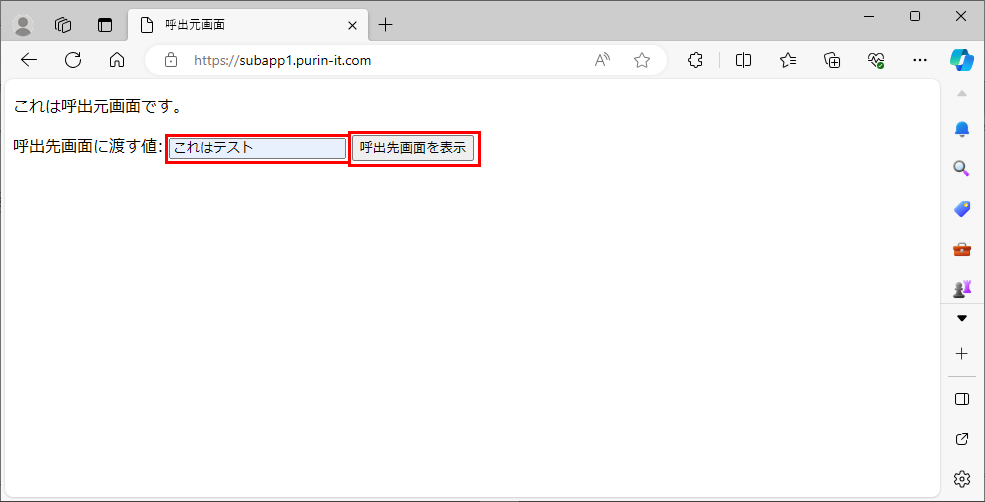
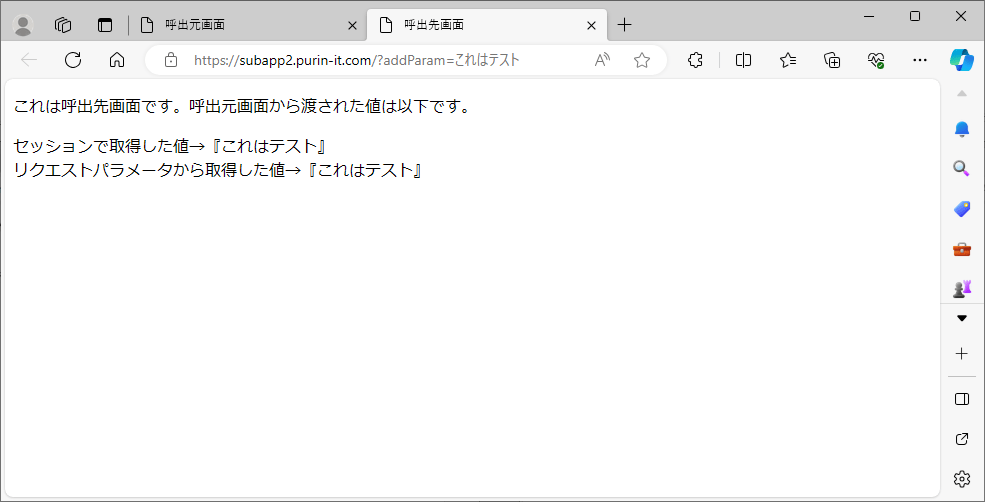
5) このときのセッションの値をAzure Cache for Redisで確認した結果は以下の通りで、呼出先画面に渡す値がセッションに格納されていることが確認できる。
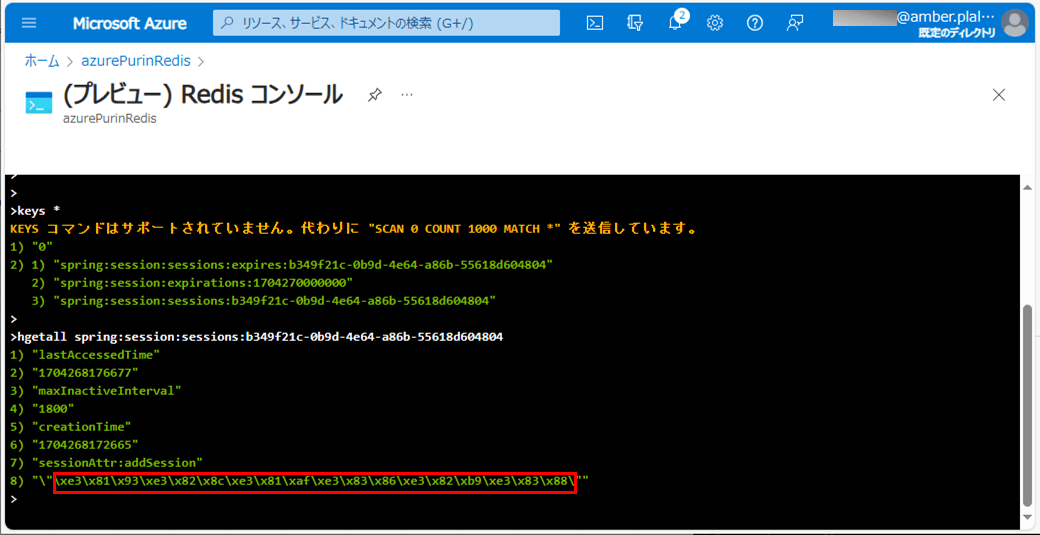
要点まとめ
- セッションデータをAzure Cache for Redisに格納するJavaアプリケーションを、複数のAzure App Serviceそれぞれに配置し、複数のAzure App Serviceが(メインドメインが同一の)サブドメインをもつ場合、セッションデータを互いに共有することができる。





